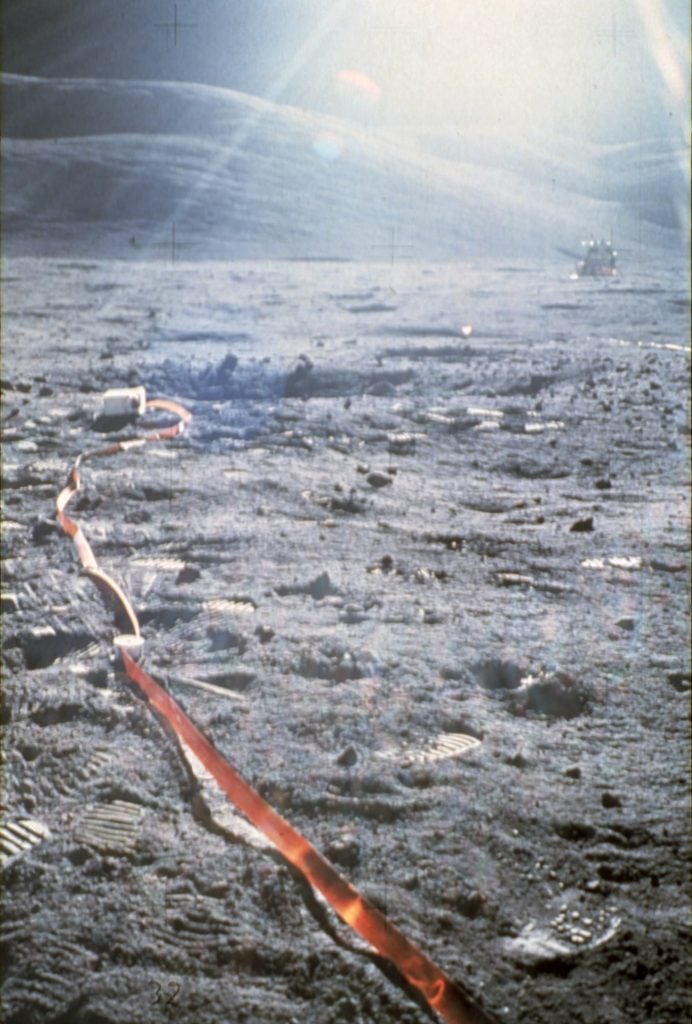Delaware companies eye a future in space while marking Apollo 11’s anniversary
Two Delaware companies that contributed spacesuits and other materials to the moon landing 50 years ago see a role in future space missions.
Listen 1:41
Patty Stoll, senior director and division manager for ILC Dover’s space systems division, stands with a suit made at ILC Dover in Frederica, Delaware for the Apollo mission. (Mark Eichmann/WHYY)
The tiny central Delaware town of Frederica seems light years away from those hubs of the space industry, Kennedy Space Center at Cape Canaveral in Florida and Johnson Space Center in Houston, Texas. But amid the cornfields of rural Kent County, workers at ILC Dover’s manufacturing facility have stitched and sewn their way to becoming a major player in outfitting astronauts.
When Neil Armstrong stepped out of the lunar lander 50 years ago this week, he was wearing a spacesuit built by ILC Dover.
“It’s an exciting time for us,” said Patty Stoll, senior director and division manager for the company’s space systems division. “It’s great to be celebrating the Apollo 11 moon landing, the 50th anniversary with our employees here.”
They looked back on the company’s history Thursday afternoon with a celebration of the lunar landing. The moonwalk by Armstrong and Buzz Aldrin was the ultimate test for ILC Dover’s product.
“You’re saving life, you’re protecting human life. Just one little thing can go wrong and that person can die, and that’s catastrophic, not just for them, but for their family,” Stoll said.
ILC Dover still provides NASA with spacesuits, including the ones astronauts wear when performing work outside the International Space Station.
“I think it’s really a sense of pride for Delaware and Frederica and Dover,” she said. “Everybody should feel pride that they’re made here.”
With more private firms planning and testing commercial space flights, and NASA looking toward returning astronauts to the moon and maybe even to Mars, ILC Dover is counting on coming along for those journeys as well.
“I kind of call it the new space race. And it’s very exciting,” Stoll said. “I would say this is the most exciting time, not just because of Apollo 11, I think that’s brought awareness to commercial space flight, but commercial space flight really opens up the universe to like, all of humanity really.”

The company recently unveiled designs for the next generation of spacesuits it hopes NASA and commercial firms will be able to use.
“Anybody can build a suit, but we’re the only ones that have built a suit that’s been on the moon and without any critical failure, so that’s a big deal,” she said.
The company has designed a launch/entry/abort suit called Sol that’s designed to be worn during launch and landing.
The Astro suit would be used for when astronauts venture outside the confines of their spaceship.
“That suit protects human life in space, and if we go to the moon and Mars, our suit will give you the [flexibility] to if you just wanted to do a spacewalk on the International Space Station or any commercial space station that may be up there.”
Stoll is hopeful the company will be selected by NASA and multiple commercial operators to outfit future space travelers.
“We’re really excited about the technology and we’re really hoping that NASA will notice it and that we’ll be able to help them, and then anybody else who’s going to be in the commercial space industry,” she said.

Farther north, near Newark, W.L. Gore & Associates Inc. is also commemorating the success of its products on the moon half a century ago. Among the equipment Armstrong and Aldrin carried onto the moon’s surface was a seismograph to measure moonquakes. The equipment was connected to the lander via a copper cable designed by Gore to withstand the harsh lunar surface.
“There was a cable that extended all the way from the lunar lander out to this equipment, and it was unrolled across the surface of the moon, and that was facing pretty tough environments,” said Dave Liss, global business leader at Gore. “You had to handle abrasion, you had to handle temperature changes, you had to handle the high performance data transfer, and high-speed data transfer that was going on, and that’s actually consistent through many of our products.”
Additional Gore cables were used in computer systems the astronauts needed to navigate from the moon back to their capsule in orbit. NASA used other Gore materials in the command center back on Earth.

“We’re really proud to be a part of the Apollo missions,” Liss said. “That sort of launched our positioning in space.”
Since Apollo, Gore materials have been used in spacecraft, and especially in satellites currently in orbit.
“We were involved in all the different generations of GPS spacecraft, in fact, some of the portions of the spacecraft where all the signal travels from the antenna back to earth goes through our cable,” he said.
Looking to the future, the company’s products will likely play an integral role for both NASA and commercial flights back to space.
“Space flight business is doing really well for us,” Liss said, “and we’re excited for the future.”
WHYY is your source for fact-based, in-depth journalism and information. As a nonprofit organization, we rely on financial support from readers like you. Please give today.





